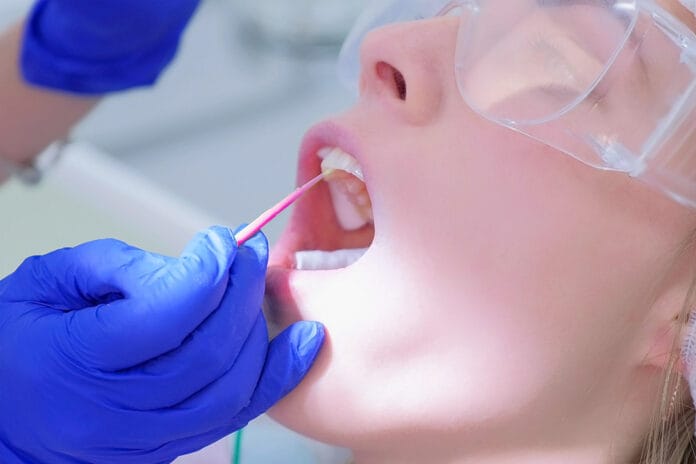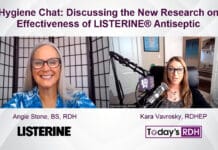Disclosure: This quiz is sponsored content from Pulpdent as part of our sponsored partner program.
Get a FREE sample of Embrace™ Varnish!
Get a free sample while supplies last of Embrace™ Varnish from Pulpdent after taking this quiz!
By incorporating xylitol-coated calcium and phosphate in a permeable resin matrix that does not separate, Pulpdent has developed a sustained time-release varnish with uniform dosage that delivers 10 times more fluoride than the leading varnish brand. The pleasing taste ensures patient compliance.
There’s more to Embrace than fluoride release:
- Pleasing taste ensures patient compliance
- Contains bioavailable calcium, phosphate and fluoride
- No mixing required
Ensures predictable, uniform dose - Bioavailable Fluoride, Calcium and Phosphate with Xylitol
Embrace Varnish also releases bioavailable calcium and phosphate ions, the essential building blocks of teeth. The xylitol coating prevents the calcium and phosphate salts from reacting until they come in contact with saliva. Saliva dissolves the xylitol and releases the calcium and phosphate ions, which react with the fluoride ions in saliva to form protective fluorapatite on the teeth.
To claim your free sample while supplies last, simply fill out the form after taking the quiz!
Now let’s test your fluoride varnish knowledge!
Test Your Fluoride Varnish Knowledge
1. Fluoride varnish's mechanism of action in the prevention of dental caries includes which of the following?
Fluoride varnish works via topical mechanisms that include inhibition of demineralization, and enhancement of remineralization, at low levels is bacteriostatic, and at high levels is bactericidal. Higher fluoride concentrations in the oral cavity can reduce the number of certain bacterial species that contribute to dental caries, such as S. mutans.1
1. Deepti, A., Jeevarathan, J., Muthu, M.S., et al. Effect of Fluoride Varnish on Streptococcus mutans Count in Saliva of Caries Free Children Using Dentocult SM Strip Mutans Test: A Randomized Controlled Triple Blind Study. International Journal of Clinical Pediatric Dentistry. 2008; 1(1): 1-9. https://doi.org/10.5005/jp-journals-10005-1001
2. Active caries in the previous 12 months, active orthodontic treatment, and restorations with open margins are all risk factors that increase the risk of developing caries. A patient with these risk factors would benefit from topical fluoride varnish application.
According to the ADA's Professionally Applied and Prescription-strength, Home-use Topical Agents for Caries Prevention Guideline (2013), patients with the following risk factors are at an increased risk for developing caries which warrants applying a topical fluoride agent.
- Active caries in the previous 12 months
- High titers of cariogenic bacteria
- Poor oral hygiene
- Drug/alcohol abuse
- Poor family dental health
- Cariogenic diet
- Genetic abnormalities of the teeth
- Many multi-surface restorations
- Chemo or H/N radiation therapy
- Eating disorders
- Active orthodontic treatment
- Irregular dental care
- Suboptimal fluoride exposure
- Developmental or acquired enamel defects
- Prolonged nursing (bottle or breast)
- Presence of exposed root surfaces
- Restoration overhangs and open margins
- Physical or mental disability inhibiting proper oral hygiene
- Xerostomia (medication, radiation, or disease-induced)1
1. Professionally-Applied and Prescription-Strength, Home-Use Topical Fluoride Agents for Caries Prevention Clinical Practice Guideline. (2013). American Dental Association. https://www.ada.org/resources/research/science-and-research-institute/evidence-based-dental-research/topical-fluoride-clinical-practice-guideline
3. It is recommended that dental clinicians prioritize the use of which of the following to arrest or reverse noncavitated carious lesions on occlusal surfaces of primary and permanent teeth?
The American Dental Association Council on Scientific Affairs and the Center for Evidence-Based Dentistry convened an expert panel that conducted a systematic review and formulated evidence-based clinical recommendations for the arrest or reversal of non-cavitated carious lesions.
The question posed to the expert panel was, "To arrest or reverse noncavitated coronal carious lesions on primary or permanent teeth, should we recommend NaF, stannous fluoride, acidulated phosphate fluoride (APF), difluorsilane, ammonium fluoride, polyols, chlorhexidine, calcium phosphate, amorphous calcium phosphate (ACP), casein phosphopeptide (CPP)–ACP, nano-hydroxyapatite, tricalcium phosphate, or prebiotics with or without 1.5% arginine, probiotics, SDF, silver nitrate, lasers, resin infiltration, sealants, sodium bicarbonate, calcium hydroxide, or carbamide peroxide?"
For occlusal surfaces, the expert panel recommended the following with moderate certainty and strong recommendations for arresting or reversing noncavitated carious lesions on primary or permanent teeth:
- Sealants plus 5% NaF varnish (varnish application every 3-6 months)
- Sealants alone
- 1.23% APF gel (application every 3-6 months)
- Resin infiltration plus 5% NaF varnish
- 0.2% NaF mouthrinse (once per week plus supervised brushing)1
The panel stated that treating noncavitated carious lesions with these recommendations "had a 2 to 3 times greater chance of being arrested or reversed than results with no treatment" and that "the combination of sealants plus 5% NaF varnish was the most effective at arresting or reversing noncavitated occlusal lesions."1
The panel emphasized that "10% CPP-ACP should not be used as a substitute for fluoride products."1 They stated, "We found no evidence on the effect of stannous fluoride, difluorsilane, ammonium fluoride, calcium phosphate, ACP, nano-hydroxyapatite, tricalcium phosphate, or prebiotics with or without 1.5% arginine, SDF, silver nitrate, lasers, sodium bicarbonate, calcium hydroxide, or carbamide peroxide for noncavitated lesions on any coronal tooth surface."1
1. Slayton, R.L., Urquhart, O., Araujo, M.W.B., et al. Evidence-based Clinical Practice Guideline on Nonrestorative Treatments for Carious Lesions. Journal of the American Dental Association. 2018; 149(10): 837-849.e19. https://doi.org/10.1016/j.adaj.2018.07.002
4. Applying fluoride gels and foams for one minute is acceptable for optimal fluoride uptake.
Though fluoride gels and foams are often applied for only one minute in clinical practice, there have been no clinical trials in humans to support the efficacy of this practice. The proper and evidence-based application time for fluoride foam and gel is four minutes.1
According to the ADA's Professionally Applied and Prescription-strength, Home-use Topical Agents for Caries Prevention Guideline (2013), the expert panel found there may be a benefit to the twice-per-year, four-minute application of fluoride foam for children under six; however, the potential harm (i.e., swallowing risk) outweighs any benefit. The panel found no benefit of fluoride foam application regarding caries prevention in children over six and adults.2
1. Fluoride Recommendations Work Group. Recommendations for Using Fluoride to Prevent and Control Dental Caries in the United States. Centers for Disease Control and Prevention. 2001; 50(RR14); 1-42. https://www.cdc.gov/mmwr/preview/mmwrhtml/rr5014a1.htm
2. Professionally-Applied and Prescription-Strength, Home-Use Topical Fluoride Agents for Caries Prevention Clinical Practice Guideline. (2013). American Dental Association. https://www.ada.org/resources/research/science-and-research-institute/evidence-based-dental-research/topical-fluoride-clinical-practice-guideline
5. Food allergies are becoming increasingly common. Which of the following oral care products used or distributed in a dental office have the highest prevalence of food allergens?
Food allergens consist of a multitude of excipients used in oral care products to improve the product. Food allergens have been found in both outpatient products and products used in-office. Outpatient products with the highest risk of food allergens are toothpaste, chewing gum, and orthodontic waxes. Products used in-office with the highest risk of having a food allergen were topical creams, fluoride varnishes, alginates, prophylactic paste, and gloves. Clinicians should be knowledgeable of ingredients and the possible food allergens present in products used and recommended to prevent allergic reactions.1
1. Coimbra, L., Costa, I.M., Evangelista, J.G., Figueiredo, A. Food Allergens in Oral Care Products. Scientific Reports. 2023; 13(1): 6684. https://doi.org/10.1038/s41598-023-33125-y
6. Pit and fissure sealants are more effective at preventing decay in permanent molars when compared to fluoride varnish.
A Cochrane Review published in 2020 found "both interventions are effective for reducing tooth decay, and current evidence does not suggest that one works better than the other."1
1. Kashbour, W., Gupta, P., Worthington, H.V., Boyers, D. Pit and Fissure Sealants versus Fluoride Varnishes for Preventing Dental Decay in the Permanent Teeth of Children and Adolescents. The Cochrane Database of Systematic Reviews. 2020; 11(11): CD003067. https://doi.org/10.1002/14651858.CD003067.pub5
7. Fluoride varnish composition does not play a significant role in fluoride uptake and release over time. The need to mix a fluoride varnish does not affect the effectiveness of the varnish.
Calcium and phosphate are building blocks of the enamel, yet the interaction between calcium and fluoride could be a problem with fluoride uptake. The addition of xylitol-coated calcium and phosphate to fluoride varnish provides better bioavailability of fluoride. Therefore, incorporating xylitol-coated calcium and phosphate prevents the interaction and allows for better fluoride uptake and release.1
A product such as Embrace Varnish (Pulpdent) contains xylitol-coated calcium and phosphate to allow better fluoride delivery and uptake. Embrace releases over 900 mcg of fluoride over a 4-hour period, a significantly high fluoride amount.1,2 The xylitol in Embrace prevents the calcium and phosphate salts from reacting until they encounter saliva. Upon release, the calcium and phosphate react continuously with the fluoride to form fluorapatite on the teeth.
The need to mix fluoride varnish that separates can cause lower fluoride release and uptake due to improper mixing. The brush used for mixing can retain the first component of the separated solution preventing proper mixing of the entire solution. Some products do not require mixing because the solution does not separate. Embrace Varnish, mentioned above, is one such product.2
1. Kusuma Eriwati, Y., Putriani, D., Geraldine, K., Hermansyah, H. Fluoride and Calcium Release from Peppermint-flavored Fluoride Varnish Containing Dicalcium-phosphate-dihydrate Coated with Xylitol. The Saudi Dental Journal. 2022; 34(1): 68-73. https://doi.org/10.1016/j.sdentj.2021.09.021
2. Yapp, R., Powers, J.M. Fluoride Ion Release from Several Fluoride Varnishes. Dent Advis Res Rpt. 2012; 44. https://www.dentaladvisor.com/pdf-download/?pdf_url=wp-content/uploads/2015/02/fluoride-ion-release-from-several-fluoride-varnishes.pdf
8. Fluoride varnish has been assigned to pregnancy category B by the FDA. Fluoride varnish should be applied during pregnancy when the need has been established.
Epidemiologic studies show no increased risk of birth defects in areas with high levels of naturally occurring fluoride. Animal studies have reported that fluoride crosses the placenta, but only 0.01% of the amount administered reaches the fetus. Topical fluoride ingestion is extremely low, making the amount administered systemically minuscule by the time it reaches the fetus. Therefore, the FDA has assigned topical fluoride to category B.1
1. Fluoride Topical Pregnancy and Breastfeeding Warnings. (2022, April 21). Drugs.com. https://www.drugs.com/pregnancy/fluoride-topical.html
9. Fluoride varnish application during pregnancy does not reduce the risk of vertical transmission of S. mutans.
Infants are exposed to oral bacteria from their mothers early in life, in many cases before the eruption of the first tooth. In a study that aimed to investigate the transfer of S. mutans to babies from their mothers in whom protective measures were carried out prior to birth compared to a control group that received no protective measures, the results indicated that managing active carious lesions and applying fluoride varnish significantly reduced the number of S. mutans in the study group. The reduced number of S. mutans in mothers reduced the risk of transferring the bacteria to their infants.1
1. Guler, E., Koprulu, H. Preventive Measures to Reduce the Transfer of Streptococcus mutans from Pregnant Women to Their Babies. Journal of Dental Sciences. 2011; 6(1): 14-18. https://www.sciencedirect.com/science/article/pii/S1991790211000043
10. Fluoride varnish is the only recommended product for professional fluoride application in children under age six. No published evidence indicates that professionally applied fluoride varnish is a risk factor for enamel fluorosis.
According to the ADA's Professionally Applied and Prescription-strength, Home-use Topical Agents for Caries Prevention Guideline (2013), only fluoride varnish is recommended for children younger than six.1
The Centers for Disease Control and Prevention states, "No published evidence indicates that professionally applied fluoride varnish is a risk factor for enamel fluorosis, even among children aged less than six years." Additionally, with proper application techniques, the amount of fluoride varnish ingested is minimal.2
1. Professionally-Applied and Prescription-Strength, Home-Use Topical Fluoride Agents for Caries Prevention Clinical Practice Guideline. (2013). American Dental Association. https://www.ada.org/resources/research/science-and-research-institute/evidence-based-dental-research/topical-fluoride-clinical-practice-guideline
2. Fluoride Recommendations Work Group. Recommendations for Using Fluoride to Prevent and Control Dental Caries in the United States. Centers for Disease Control and Prevention. 2001; 50(RR14); 1-42. https://www.cdc.gov/mmwr/preview/mmwrhtml/rr5014a1.htm











